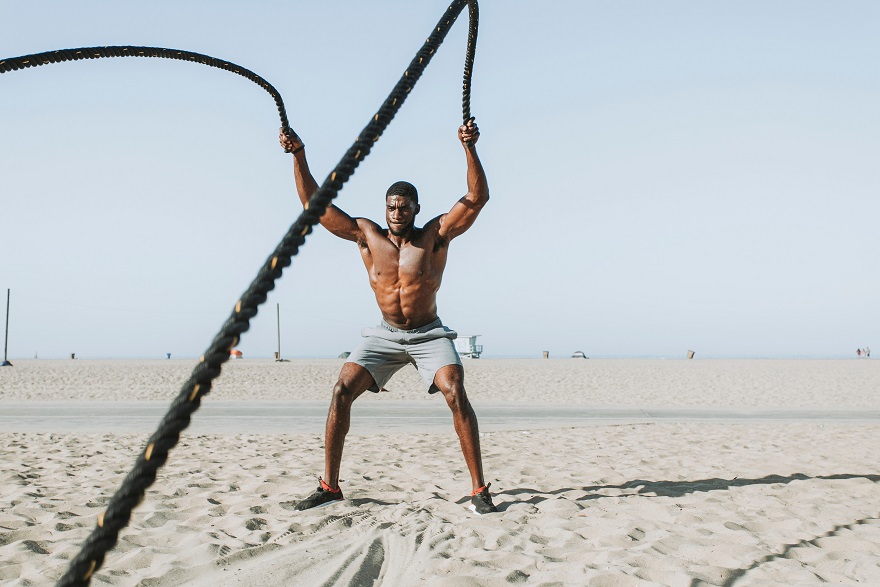Pexels: Andrea Piacquadio
A lot of people do cardio wrong. What are the most common cardio mistakes? And how can you correct them? We have science-backed solutions. Let’s get steppin’ and learn how to maximize the calorie burn.
CARDIO WORKOUT MISTAKE: BAD TIMING
Cardio has traditionally been thought of as a warmup activity, thus many bodybuilders do it before weight-training. This both robs energy from their iron workout and limits their fat burning. The American Council on Exercise sums up the science: If your goal is better endurance, you can do cardio before weight-training. Tiring yourself out first, in this case, can be a plus. However, if your goal is burning fat and losing weight and/or gaining strength or muscle size, do cardio after weight-training. A 2014 study determined “resistance exercise performance is significantly compromised in healthy men after aerobic exercise.” A meta-analysis of 21 studies determined the same. And a 2007 study demonstrated that when trainers did cardio immediately after weight-training they burned approximately twice as much fat as when they did cardio in a separate workout. This was due to the subjects’ elevated growth hormone levels after hitting the iron.

Others prefer to do cardio in a workout separate from their weight-training. If you choose to do this, the best time is soon after waking on an empty stomach (or with only some whey protein but no carbs). This is fasted cardio. Food you ate the day before has been processed and digested, so your glycogen levels are low and your body might be stoked to more readily use body fat as fuel. There is conflicting evidence about the effectiveness of fasted cardio. Nevertheless, if you’re going to do a cardio workout separate from weight-training, the best time for it is pre-breakfast. That said, not everyone has a schedule that permits them to do fasted cardio, and there is nothing wrong with doing cardio at other times of the day. For many the best time for a separate cardio workout is when they have time.
SOLUTIONS
If you do your cardio with your weight-training, do it immediately after hitting the weight. Research has shown that the fat burning is at its greatest during the first 15 minutes of cardio, though we recommend you go for at least 20.
If you do cardio separate from weight-training, the best time to do it is first thing in the morning on an empty stomach.
You may want to include some cardio action as a warmup, especially on leg day, just to loosen up and prime the pump. If so, keep your pre-workout time on a stationary bike or stepmill to 15 minutes or less.
CARDIO WORKOUT MISTAKE: NEGLECT
Too many exercisers neglect cardio, either feeling diet alone will excavate their abs or thinking hours on the treadmill will deplete their muscular gains. There is a prevalent fear that exercising away calories will burn up the very nutrients you need to grow. Let’s unpack this thinking. First, the choice is never between diet and cardio, but if it was, the properly timed burning of calories via exercise would likely spare more muscle than reducing calories via dieting. Second, the many metabolic and cardiovascular benefits of boosting your heart rate and endurance, especially in regards to heart health, are reasons enough to do cardio at least twice-weekly year-round.
SOLUTIONS
Cardio comes last in the gym but don’t make it an afterthought. Schedule time. If necessary, arrange your split so you have briefer workouts before cardio.
Starting with low-intensity 20-minutes sessions, gradually increase the duration and intensity of cardio until you’re doing at least two moderate-intensity 30-minutes sessions per week. Then you’ll be ready to crank it up further with HIIT, which brings us to mistake #3.

CARDIO WORKOUT MISTAKE: INCORRECT INTENSITY
Weight-trainers tend to be of two minds on cardio: slow-and-steady so as to not exhaust their energy reserves (for those who do cardio before weight-training) or fast-and-furious, adopting the same take-no-prisoners approach they apply to barbells and dumbbells. In fact, though both approaches will burn fat, neither is ideal. Studies have demonstrated that the best approach combines both low- and high-intensity. It’s high-intensity interval training (HIIT), and not only will it stoke your fat-zapping metabolism, it can also reduce the amount of time you spend striding in place.
SOLUTIONS
Begin with a three-minute warmup at a slow pace. Then alternate one minute at a quick pace (fast jog on treadmill) with one minute at a slow pace (walking on treadmill). End with a three-minute cooldown at a slow pace.
Depending on your endurance, when first doing HIIT, you may need to lengthen the slow pace intervals, but build up to where you’re alternating slow and quick intervals equally for 20-30 minutes.
HIIT can be done outside, alternating one-minute runs with one-minute walks.
For much more on HIIT, see our HIIT Workout Guide.
CARDIO WORKOUT MISTAKE: TREADMILL BLAHS
The number one reason exerciser shortchange cardio is because of the tedium of standing in the same spot, moving without moving for a half-hour or more. Even with all the modern electronic diversions, plodding along on a treadmill or stepmill is nobody’s idea of fun.
SOLUTIONS
Most modern gyms have more than just treadmills, stepmills and stationary bikes. Take advantage of your gym’s variety. Elliptical trainers, rock climbing machines, tread climbers, and rowing machines are just some of the other devices, and higher tech versions of old machines are released regularly. To stay inspired, use a different type of machine each workout.
Split your cardio in two. Work a muscle group, do 20 minutes of cardio, work another muscle group, and finish with 20 minutes of cardio. This doesn’t just stave off boredom. Research comparing a 60-minute cycling session with two 30-minute sessions divided by 20 minutes of rest, demonstrates shorter sessions are more effective for fat loss than one longer session. This is likely because of intensity of effort.
Go outside. Jog, hike, swim, ride a bicycle, play basketball. Nobody said you had to do your cardio in a gym. Doing at least some of it outdoors via sports and other aerobic activities will instantly solve your treadmill blahs.

CARDIO WORKOUT MISTAKE: INSUFFICIENT RECOVERY
The fear of some weight-trainers that cardio will waste away their hard-earned muscle may be exaggerated but it is not entirely unfounded. After all, treadmills, stepmills, and the like will involve lower body muscle action, just as battle ropes and rowing machines hit the upper body, and if you’re plodding along for too long and/or too often the extra work may indeed stifle recovery and growth.
SOLUTIONS
Just as high-intensity (HIT) workouts use a minimum amount of iron time, HIIT can reduce your cardio to as little as 20 minutes, twice weekly, thus limiting the muscular workload.
Regularly alternate cardio exercises to stimulate different muscles.
Don’t do leg-intensive cardio on leg day, and you may also want to avoid it the day after an especially intense leg workout.
Similarly, you may want to avoid upper body cardio on days you have especially intense upper body workouts. For example, rowing after a back workout may add too many extra reps of lat work.
CARDIO WORKOUTS: LESSONS LEARNED
Do your cardio immediately after weight training or in a separate workout (ideally first thing in the morning).
Segment time for cardio and build up the duration of sessions.
Utilize high-intensity interval training.
Employ a variety of machines and activities in and out of the gym.
With an eye to your weight training, arrange your cardio sessions and exercises to avoid overtaxing muscles.
FURTHER READING
Best Time to Do Cardio for Optimal Results
















































